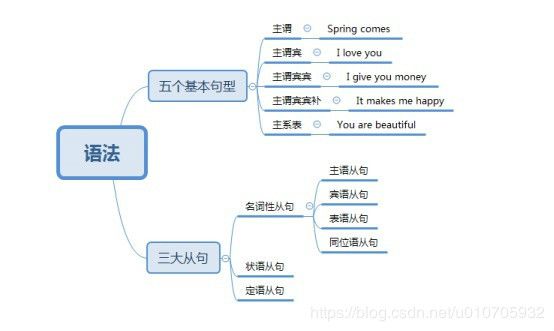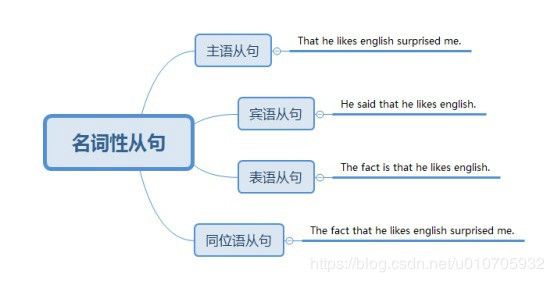英语语法篇
语法无非三点。第一点是五个基本句型:主谓、主谓宾、主谓宾宾、主谓宾宾补、主系表。任何高阶复杂的句子都是从这五种简单句型演化而来。第二点是三大从句:名词性从句、状语从句、定语从句。第三点是其他形式:主语从句、宾语从句、表语从句、同位语从句。
1. 五个基本句型
英语句子是由主语、谓语动词、表语、宾语、宾语补足语等组成。英语句子有长有短,有简有繁,似乎千变万化,难以捉摸,但其实只有五种基本句型。所有英语句子都可以看成是这五种基本句型的扩大、组合、省略或倒装。因此掌握这五大句型,是掌握其他各种英语句子结构的基础。
英语句子依其组合方式可分为以下五种基本句型,句子成分的表示法为:主语(Subject),动词(Verb),宾语(Object),间接宾语(Indirect Object),直接宾语(Direct Object),表语(Predicative),宾语补足语(Object Complement)。
| 句型 | 结构 | 例句 |
|---|---|---|
| 主谓 | 主语+不及物动词 | Class begins. |
| 主谓宾 | 主语+及物动词+宾语 | We like English. |
| 主谓宾宾 | 主语+及物动词+间接宾语+直接宾语 | My mother gave me a present. |
| 主谓宾宾补 | 主语+及物动词+宾语+宾语补足语 | The teacher asked me to practise English. |
| 主系表 | 主语+系动词+表语 | They all look fine. |
1.1 主谓
主语+不及物动词: Class begins.
-
Birds fly. 鸟飞。
主语+谓语 (不及物动词) -
He runs in the park. 他在公园里跑。
主语+谓语 (不及物动词) +地点状语
此句型是“主语+不及物动词”构成句子的主体部分。因为是不及物动词,后面当然不能带宾语,但是可以有状语来修饰。例如上面例句中的 in the park就是地点状语。
- Class begins.(begin在句中是不及物动词)上课了。
比较:We begin our class at eight. 我们八点钟开始上课。
该句则属于第2种句型,begin在句中是及物动词,由此可见有些动词既可作及物动词也可以作不及物动词。
只能当不及物动词的词(必背!):
| 单词 | 翻译 | 单词 | 翻译 | 单词 | 翻译 | 单词 | 翻译 |
|---|---|---|---|---|---|---|---|
sleep |
睡觉 | walk |
步行 | swim |
游泳 | happen(take place) |
发生 |
go |
去 | come |
来 | work |
工作 | laugh |
笑 |
stay |
呆在 | arrive |
到达 |
1.2 主谓宾
主语+及物动词+宾语: We like English.
- You must
listen tome. 你必须听我的。
主语+不及物动词+介词+宾语
Listen是不及物动词。但加上to之后,listen to可以看成一个及物动词。
有些不及物动词后面加上介词就可把它看成一个及物动词,后面就可以加宾语。
可以带宾语的动词是及物动词,可以充当宾语的有名词和名词的相当语(如代词、不定式、动名词及宾语从句)。
-
She likes
English. 她喜欢英语。
名词作宾语 -
I know
himvery well. 我非常了解他。
代词作宾语 -
They want
to go. 他们想走。
不定式作宾语 -
He stopped writing. 他停下笔。
动名词作宾语 -
The teacher advised
that we learn English well. 老师建议我们学好英语。
宾语从句
1.3 主谓宾宾
主语+及物动词+间接宾语+直接宾语: My mother gave me a present.
-
He gave Tom a present. 他给了汤姆一件礼物。
主语 + 谓语(及物)+ 宾(间接)+宾(直接) -
Give it to me. 把它给我。
谓语(及物)+ 宾(直接)+宾(间接)
及物动词作谓语时,后面要跟宾语,宾语分直接宾语和间接宾语。直接宾语是及物动词的直接对象。
但有些动词,除了直接宾语外,还要求一个间接宾语,这个间接宾语通常是及物动词的动作所涉及的人或物,也可以说是间接宾语表示动作是对谁做的,或是为谁做的,所以只能是名词或宾格代词担当。
(必 背!)常带双宾语(直接宾语和间接宾语)的动词(分为A、B两类)。
A:动词后加to:
| 单词 | 翻译 | 单词 | 翻译 | 单词 | 翻译 | 单词 | 翻译 |
|---|---|---|---|---|---|---|---|
give |
给 | show |
给··看 | send |
寄,打电报 | bring |
带·· |
read |
读·· | pass |
递给·· | lend |
借给·· | leave |
留给·· |
hand |
交给·· | tell |
告诉·· | return |
把··还给·· | write |
给··写信 |
B:动词后加for:
| 单词 | 翻译 | 单词 | 翻译 | 单词 | 翻译 |
|---|---|---|---|---|---|
buy |
给/为某人买·· | draw |
替/给某人画·· | make |
为某人制作·· |
【秘 诀】 “七给”“一带”to不少, “买”“画”“制作”for来了。
【说 明】 常跟双宾语的动词:
“七给”(give, hand, lend, pass, show, send, write)和“一带”(bring)8个及物动词,在直接宾语前置时,必须在后面加上to,即:“vt.+sth.+to+sb”。
buy,draw,make三个动词,在直接宾语前置时,则必须在后面加for,构成“vt.+sth.+for+sb”句型。
1.4 主谓宾宾补
主语+及物动词+宾语+宾语补足语: The teacher asked me to practise English.
在此句型中的动词,叫做可以跟复合宾语的动词,在英语中,这样的动词也不多。后面的宾语补足语说明宾语的情况,宾语和宾语补足语一起被称做复合宾语。这个句式是英语中比较复杂的一个句式,因为复合宾语的构成内容较多。
-
He found his new job
boring.
形容词做宾补 -
They called their daughter
Mary.
名词做宾补 -
This placed her
in a very difficult position.
介词短语做宾补 -
We went to her house but found her
out.
副词做宾补 -
What do you advise me
to do?
不定式做宾补 -
We thought him
to be an honest man.
to be做宾补 -
He believed them
to have discussed the problem.
不定式的完成式做宾补 -
He believed her
to be telling the truth.
不定式的进行式做宾补 -
Did you notice him
come in?
不带to的不定式做宾补
【秘 诀】不定式,作宾补,下列词后省去to:四“看见”,三“使役”, 二“听”, 一“感”, 半“帮助”。保你永远会记住。
【说 明】“半帮助”指help,可以带也可以不带to;“一感”指feel;“二听”指hear, listen to;三个“小使役”指have, let,make三个使役动词;“四看见”指notice,observe,see,watch,在这些动词后有不定式作宾补时,不定式的符号to往往往要省去。
-
I saw her
chatting with Nancy.
现在分词做宾补 -
He watched the piano
carried upstairs.
过去分词做宾补
在这个结构中,可以出现用it做形式上的宾语,把真正的宾语放在宾语补足语的后面。在此结构中,宾语常常是动词不定式或宾语从句。
-
He felt it his duty to mention this to her.
分析:it是形式宾语,his duty是宾语补足语,to mention this to her是真正的宾语。 -
I think it best that you should stay with us.
分析:it是形式宾语,best是宾语补足语,that you should stay with us是真正的宾语。
习惯用语的使用:在英语中,有很多动词习惯用语,在学习的过程中,要注意它们的使用,不必分析单独每个词的使用。
- We are short of money. (be short of中short作表语)
- She is always making trouble for her friends. (trouble做make的宾语)
- He has carried out our instructions to the letter. (our instructions做词组carry out的宾语)
- We are waiting for the rain to stop. (wait for后面的the rain是宾语,to stop是宾语补足语)
在英语中,大多数动词既可以做及物动词又可以做不及物动词,而且还会有一些固定词组,因此一个动词可以用于几种句型。例如:ask。
- Did you ask the price?(直接接名词做宾语)
- She asked them their names. (接双宾语)
- I asked James to buy some bread. (接宾语加不定式做宾语补足语)
- I asked to speak to Fred. (接不定式做宾语)
- Didn’t you ask him in?(在此句中和副词in连用)
- He has asked for an interview with the President. (组成固定词组ask for)
There be句型是一种特殊的句子,真正的主语在后面,含义为“有···“。
-
谓语动词和主语保持一致:
There is a television in the sitting room. -
有两个或更多的主语时,动词一般和最近的一个保持一致:
There are two girls and a boy dancing in the hall. -
主语的后面有时有修饰语:
There are a lot of difficulties facing us. There were many things to be done.(此处也可以使用to do). -
谓语动词be可以有时态的变化:
There will be a concert in the park tonight. There was little change in him. -
谓语也可以有不定式构成的复合谓语。
There used to be a cinema here.
There seems to be something the matter with her.
Is there going to be any activity tonight? -
there be句式变疑问句,把be提前;变翻译疑问句也要借助there。
Is there any hope of getting the job?
There is nothing wrong with your watch,is there? -
there be句型中也可以使用诸如:live,follow,come,stand,sit,exist等不及物动词:
Once upon a time, there lived a fisherman on the island.
There came a knock at the door.
At the top of the hill there stands an old temple. -
用于非谓语的情况下,有时用不定式的复合结构there to be或动名词的复合结构和独立主格结构there being:
You wouldn’t want there to be another war. (不定式的复合结构)
The teacher was satisfied with there being no mistakes in his homework. (动名词的复合结构)
There being nothing else to do,we went home. (独立主格结构)
1.5 主系表
主语+系动词+表语: They all look fine.
- He
becamea scientist. 他成为了一个科学家。
be动词和become是英语中常见的系动词,后面必须接表语,才能用来说明主语,表示
“··是··”和“··变成··”等意思。表语通常是名词或形容词等。
-
They are
honest. 他们是诚实的。
形容词作表语 -
He is a
teacher. 他是一名老师。
名词作表语
在英语中,除了be动词和become属于系动词外,还有一些实义动词在表示状态存在或表示状态变化时也可以作系动词。这些词有:
| 单词 | 翻译 | 单词 | 翻译 | 单词 | 翻译 | 单词 | 翻译 |
|---|---|---|---|---|---|---|---|
keep |
保持 | look |
看起来 | feel |
觉得 | smell |
闻起来 |
sound |
听起来 | taste |
尝起来 | grow/get/go/turn |
变得 | remain |
仍然是 |
参考资源
[1] 知乎-如何学习英语?
[2] 百度文库-英语中五种基本句型详解

